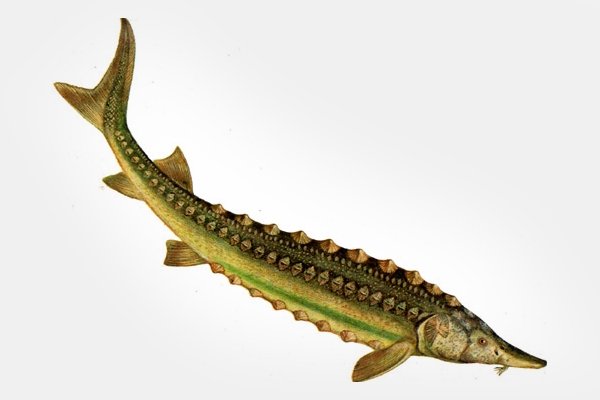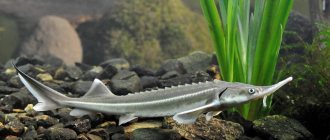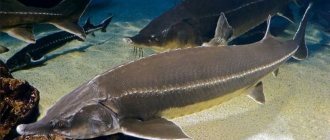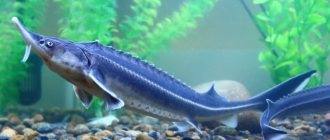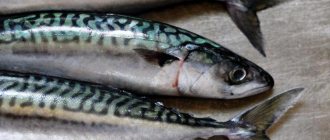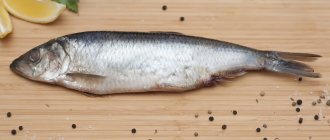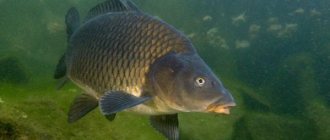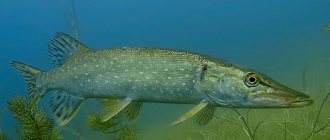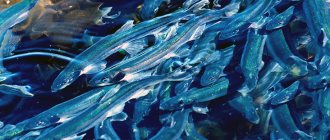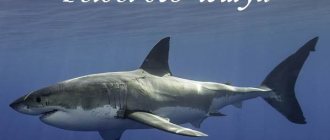Description of kaluga fish
The fish belongs to the sturgeon family and is often confused with beluga . But its main distinctive and easily recognizable feature is the number of rays on the dorsal fin - there are less than 60 of them.
Appearance
Kaluga is very large, sometimes adult individuals grow up to 560 cm in length and weigh more than 1 ton. - the fish is considered sexually mature at the age of 16 years, when it reaches a length of 230 cm and weighs about 380 kg. The total life expectancy of Kaluga is 50-55 years. The color of the animal is most often greenish-gray, the belly is usually white.
This is interesting! The gill membranes of such fish are fused together, forming a wide fold under the space between the gills.
The muzzle or snout is slightly pointed, conical in shape, not long and slightly flat on the sides. The mouth is quite large, shaped like a crescent and is located along the entire lower part of the snout, extending slightly onto the head. Along the edges of Kaluga's mouth there are compressed mustaches, without leafy appendages.
Behavior and lifestyle
There are several subspecies of fish : migratory, estuary and fast-growing Kaluga. All these animals rise to spawn in the Amur. There is also residential Kaluga - its peculiarity is considered to be a “sedentary” lifestyle - fish never descend into the Amur estuary, and do not move along its bed.
How long does Kaluga live?
Sexual maturity of females and males in Kaluga does not occur at the same time - males mature 1-2 years earlier. The fish is “ready” to reproduce at 15-17 years of age, provided it reaches a size of about 2 m. Presumably, the lifespan of each individual is about 48-55 years.
Return to content
Description, structure and characteristics
Sturgeon is a big fish. The body length of large species can reach about 6 meters. The maximum weight of the fish is 816 kilograms. This is exactly the body mass of the world's largest white sturgeon. But the average commercial fish weighs 12-16 kilograms.
The fish has a small head and an elongated snout, spatulate or cone-shaped. Retractable mouth, 4 antennae at the end of the snout. The lips are fleshy, the lower lip is torn, there are no teeth. The fry grow small teeth, but disappear over time. The gill openings of sturgeons are the same as those of sharks; regular gill rakers are located on their inner surface.
The sturgeon's skeleton consists of cartilaginous tissue, there are no vertebrae, the notochord is preserved throughout the life of the fish. The body is spindle-shaped and highly elongated. The fish has no scales, but its body is covered with five rows of special scutes-bugs - diamond-shaped bony scales. Each species of sturgeon is characterized by a certain number of bone bugs.
The sturgeon has a hard pectoral fin, its front ray, similar to a spine, is especially thick and pointed. As a rule, the age of the fish is determined by the transverse cut of the front ray. The dorsal fin has from 27 to 51 rays. The anal fin may contain from 18 to 33 sharp rays.
The sturgeon is most often gray in color. The color of the back can be light gray, light brown, grayish-black, yellowish or green. The fins are characterized by a dark gray tint, the sides are brownish, the belly is white, gray with blue or grayish with yellow.
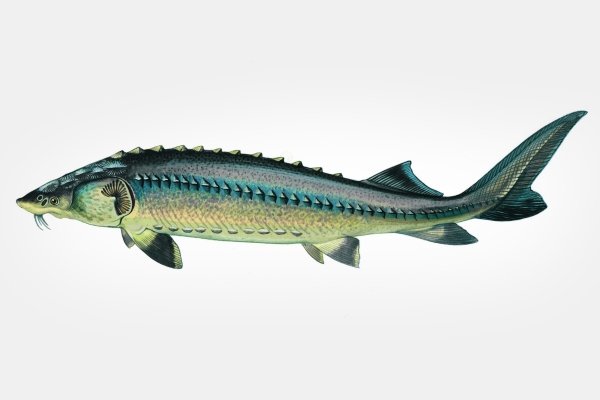
Sturgeon is one of the long-living fish. On average, fish live 40-60 years, while the lifespan of some fish can reach 100 years.
Kaluga diet
Kaluga is a typical formidable predator; in the first years of its life it feeds on smaller relatives and invertebrates . Older individuals devour fairly large species of river fish - salmon are often the preferred “delicacy” for Kaluga.
In the Amur Estuary (the habitat and spawning habitat of Kaluga), chum salmon and pink salmon become the main food, and due to a significant decrease in the population of all commercial fish in recent years, cases of cannibalism are not uncommon.
When open, the predator's mouth resembles a pipe - it literally sucks in its prey along with the flow of water. The fish's appetites are quite large - a three-meter Kaluga can easily swallow a meter-long chum salmon or pink salmon - the stomach can perfectly accommodate up to a dozen fish of this size. This appetite allows the species to grow quite quickly and reach significant sizes.

Return to content
Nutrition
Adult kaluga feed mainly on fish; large - chum salmon, pink salmon, carp, grass carp, silver carp. In the Amur estuary, in addition to migratory salmon and lamprey, it feeds on shrimp, herring, smelt, whitefish and juvenile navaga and flounder, and also eats its own juveniles before the start of the pink salmon run. In winter, food does not stop. Small - minnows, lamprey, ide, etc.; fry - mosquito larvae, freshwater shrimp, mysids, etc. Small salmon eat minnows, juvenile horses, chebak and even killer whales.
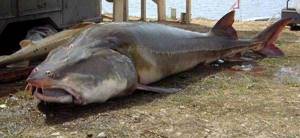
Reproduction and offspring
The very fact of the appearance of such fish in the Amur is still considered very interesting and mysterious. Scientists explain this by the long migration of fish from the western regions of the sea in the distant past. But it still remains a mystery when, how and for what reason these sturgeon appeared in the Amur Estuary. There is even a version that Kaluga populated the Amur thanks to migratory birds that carried its eggs - but this belief is so absurd that it cannot be an obvious fact.
Kaluga spawns only on sandy or pebble soil. Spawning always takes place in May - June. The mass of eggs before spawning is about 25% of its total weight, and fertility reaches up to 4-5 million eggs. Spawning of each individual occurs once every four to five years.
The eggs themselves are glued to the bottom substrate - the eggs have a diameter of about 2-4 mm. Embryos develop under certain conditions - the ambient water temperature is required to be at least 18-19°C. Egg maturation occurs within 100-110 hours; at lower temperature conditions, embryonic development slows down to 15-17 days. The hatched embryos reach a length of 10-12 mm; after a few days, again subject to a certain ambient temperature, the fish grow to 18-22 mm and completely switch to a mixed type of independent feeding.
By the beginning of winter, the fry reach a size of about 30 cm and a weight of 20-100 g. Over the course of a year, the fish grows up to 35 cm and gains weight up to 150-200 grams. Interestingly, Kaluga fry become predators early - at this age they often experience cases of cannibalism, and representatives of this particular breed of fish grow much faster than all other sturgeon.
Important ! It is in the Amur estuary and in the middle sections of the river that fish grow much faster than in other places where they live.
Individuals are considered sexually mature at the age of 20 to 25 years, having reached 100 kg and 230-250 cm in length. The sex ratio among fish that have not reached puberty is approximately the same, but adult females from Kaluga are twice as numerous.
Return to content
Species and habitats of sturgeon
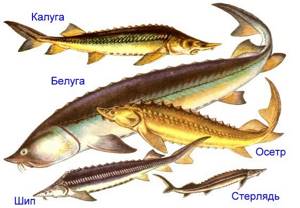
The habitat of sturgeons is the waters of the Northern Hemisphere, they are distributed all the way to the Tropic of Cancer. According to the method of spawning, the family is divided into varieties:
- checkpoints;
- semi-through;
- freshwater
An anadromous species of sturgeon is a spring and winter fish that migrates from salty seas to rivers for spawning grounds. The spawning period for spring fish is spring and summer, when the water temperature is from 15 to 20 C.
Winter fish come in the fall to a fresh lake or river for wintering. Semi-anadromous sturgeon spawn at river mouths and feed near the seashore, since they need half-salt water for normal life.
Freshwater are permanent inhabitants of rivers and lakes of the temperate zone, their second name is residential.
All sturgeons have common characteristics:
- respectable size (for example, belugas can grow up to 500 kg);
- long life expectancy (from 100 to 20 years);
- incredible fertility (one individual can contain more than a million eggs);
- appearance;
- diet;
- Lifestyle.
Puberty in sturgeon fish is later. Females are considered sexually mature at 10-15 years, males at 10-12 years. As for the sterlet and shovelnose, they reach sexual maturity much earlier.
An individual (except for sterlet) does not reproduce every year; when the fish goes to spawn, it hardly feeds.
They stay mainly near the bottom of the reservoir, where they catch small fish, worms, mollusks, and insects.
Up
Natural enemies
Since the Kaluga fish is a predator and reaches very large natural sizes, it has no enemies in nature . But Kaluga is a fairly valuable commercial fish - a real “treasure” for the fisherman - its meat is not tender and very tasty. In addition, the fish has practically no bones. It is these advantages that have made the animal the target of massive illegal fishing.
Poachers illegally catch immature individuals weighing from 5 to 20 kg, which naturally reduces the population of the species. As a result of such catching, the number of the species decreased several dozen times, as did its spawning run, which was the reason for the inclusion of Kaluga fish in the Red Book. It is possible to save a species from extinction only if natural and poaching of the population is completely stopped and artificial reproduction is carried out under certain conditions.
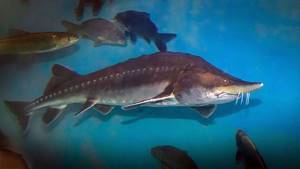
Return to content
Population and species status
Today, Kaluga fish have been assigned the status of an endangered species . Its population numbers only 50-55 thousand mature individuals (aged 15 years and over, weighing about 50-60 kg, 180 cm long). Over the past few years, a significant decline in the number of the species has been observed, which is associated with poaching of the population. If this continues, then by the end of this decade the population of Kaluga will decrease tenfold. And in a few decades, Kaluga’s population may disappear completely.
Return to content
Harm to beluga fish and contraindications
Beluga can cause harm only if there is an individual intolerance to the product, and therefore this is an absolute contraindication to its use. It is worth limiting the amount of consumption in the presence of edema, diabetes and gastritis, as well as inflammatory kidney diseases.
Similar food products
- Vobla
- Pink salmon
- Ruff
- Asp
The nutritional value
| Water | 70 g |
Vitamins
| Vitamin PP (Niacin Equivalent) | 2.905 mg |
Commercial value
Fish of the sturgeon family, including Kaluga, have always been considered the most valuable in all certain parameters. But the caviar of such fish is most valued, since it contains a huge amount of quite valuable nutrients - iodine, omega-3 fatty acids, minerals, vitamins and easily digestible fats, so necessary for the human body. In addition, the special structure of the bony skeleton in a certain way influences the almost complete human consumption of this fish - the absence of bones and the cartilaginous spine make it possible to use almost 85% of its body for preparing dishes from Kaluga.
This is interesting! From a medical point of view, fish cartilage is a natural chondoprotector, the use of which slows down the development of arthrosis and osteoarthritis.
Minimal weight loss after heat treatment, the amount and location of adipose tissue in Kaluga fish make it the most preferred gastronomic product. It is these factors that become fundamental for the capture of animals on a huge scale and are the main “culprits” for the extinction of the species.
Return to content
Types of sturgeon
In Russia, sturgeon live in places from the White Sea to the Caspian Sea. Fish are found in the basins of Siberian rivers, in the east - in the Pacific Ocean, in the west, sometimes in the Baltic Sea.
Amursky
It is found in the basins of the Amur River, including in floodplain lakes: Kizi, Boloni, Orel-Chle. The Amur sturgeon is distinguished by the presence of smooth gill rakers with 1 apex. An endangered species. The length of the Amur sturgeon reaches 3 meters and weighs about 190 kilograms, the average weight does not exceed 56-80 kilos.
Representatives of sturgeon are distinguished by their pointed, elongated snout. The fish feeds on larvae of mayflies, caddis flies, lampreys, various crustaceans, and small fish. During the spawning period, schools of fish go up the river to the Nikolaevsk-on-Amur region.
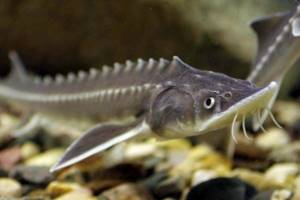
Kaluga
A fish belonging to the beluga genus. It is a large fish, the length of which reaches more than 4 meters and weighs up to 1000 kilograms. Kaluga is considered a long-liver, because with a weight of about 600 kilograms it can live up to 50 years. The diet includes fish: pink salmon, silver carp, carp, chum salmon. Small individuals feed on minnows and lampreys. Puberty occurs late - by 18-20 years.
Inhabits the Amur basin along its entire length. Found in Lake Orel, Ussuri. Does not go into the Sea of Okhotsk.

Atlantic (Baltic)
A large fish, the length of which can reach 6 meters. The maximum recorded weight of the fish is 400 kilograms. The Atlantic sturgeon has large bugs and has three pairs of large fused scutes on its tail. The back color of the Atlantic sturgeon is grayish-olive, the sides are lighter than the back, and the belly is white.
The habitat is the Black Sea and the Bay of Biscay, where no more than 300 individuals are found. A small number of fish are found only in France in the Garonne River.
The Atlantic sturgeon prefers to feed on small fish (gerbil, capelin, anchovies), worms, crustaceans and mollusks.
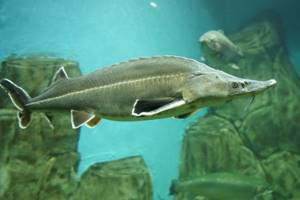
Stellate sturgeon
A large fish, the length of which reaches 2.2 meters and weighs about 80 kilograms. It is characterized by an elongated, narrow, slightly flattened snout. The back of the sturgeon is black-brown, the belly is white, the sides are lighter than the back.
Stellate sturgeon prefers to feast on mysids, crustaceans, various worms and small fish. The stellate sturgeon lives in the basins of the Black, Azov, and Caspian seas. During the spawning period, the fish goes to Kodori, Volga, Inguri, Ural, Southern Bug, Kura, Dnieper, Kuban, Don.
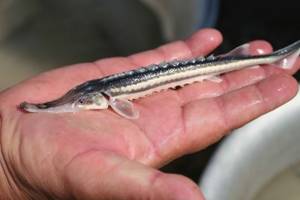
Sterlet
The natural habitat of the sterlet is the rivers of the Baltic, Black, and Azov seas. Fish is found in the following rivers: Ural, Dnieper, Sura, upper and middle Kama, Yenisei, Irtysh, Ob, Volga, Don. Previously, sterlet was found in Lakes Onega and Lake Ladoga. The fish is considered a vulnerable species.
Sterlet is a medium-sized fish. Puberty occurs early: males are ready for spawning at the age of 4-5 years, females - at 7-8 years. Another difference between the sterlet and other sturgeons is the presence of fringed antennae and a large number of lateral bugs: there are more than 50 of them.
Sterlet is a freshwater fish, but there are few semi-anadromous forms. The maximum length of the sturgeon variety reaches 1.25 meters and weighs 16 kilograms. The average size of a sterlet is 40-60 centimeters. The snout of the fish is sharp or blunt, the color varies from brownish-gray to brown. The belly is white with yellowish tint.
Sterlet feeds on insect larvae, leeches, other bottom organisms, and small fish in small quantities. A valuable hybrid form of sterlet and beluga is bester.
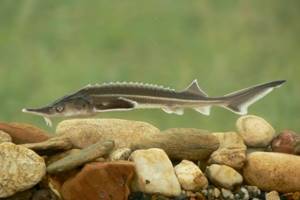
Read about breeding sterlet at home here.
Thorn
The advantage of the sturgeon is that it thrives equally well in both fresh and salt water, due to which its habitat extends over many kilometers. Representatives of this species are found in the Black, Caspian, Azov, Aral Seas, and in river basins adjacent to these reservoirs. Many individuals live in the Sefidrud River, the Urals, and the Kura.
Adult spiny fish can reach more than 2 meters in length, but many representatives of this species are smaller. The spine is characterized by an elongated body with cone-shaped spines on the back. Unlike other representatives of sturgeon, the sturgeon has fringed antennae located near the lower lip.
The color of the thorn varies from light gray to greenish, the belly is light. There are star-shaped scales on the surface. Thorn is a fish listed in the Red Book of Russia.

Ozerny
The lake sturgeon is a large fish with a blunt snout. The maximum size officially registered is 2.74 meters with a weight of 125 kilograms. The sturgeon's body color can be greenish-brown, black with a gray tint. The belly is white or slightly yellow.
The diet of the lake sturgeon includes all kinds of bottom microorganisms; the sturgeon feeds less often on fish. The fish's habitat is the Great Lakes system, Lake Winnipeg, and the basins of the Saskatchewan, Mississippi, and St. Lawrence rivers.

Russian (Caspian-Black Sea)
A valuable species of sturgeon, which has gained popularity due to the exceptional gastronomic qualities of its meat and caviar. An endangered species. The fish has a blunt, short snout and antennae growing towards the end of the snout. The maximum length of an adult reaches about 2.36 meters and weighs 115 kilograms. But usually the weight of Russian sturgeon is 12-24 kilograms with an average length of 1.45 meters. The color of the back is grayish-brownish, the sides are with a yellow tint, and the belly is white.
The Russian sturgeon lives in all major water areas of Russia. Found in the basins of the Caspian, Azov and Black Seas. During the spawning period, fish go to the Mzymta, Psou, Volga, Rioni, Terek, Danube, Don, Dnieper, Kuban, Samur and other rivers.
Depending on the habitat, the diet of representatives consists of worms, mysids and amphipods. Russian sturgeon prefers to eat fish: shemaya, mullet, herring, sprat. Under natural conditions, the sturgeon produces hybrid offspring with thorn, stellate sturgeon, sterlet and beluga.
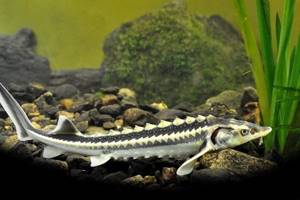
Persian (South Caspian)
The Persian sturgeon is an anadromous species that is a close relative of the Russian sturgeon. Conservation status: critically endangered. The maximum size of a sturgeon is 2.42 meters and weighs 70 kilograms. Representatives are characterized by a large, long, slightly curved snout and a gray-blue back, blue sides with a metallic tint.
The fish's diet consists of benthos and small fish. Sturgeon is found in the middle and southern regions of the Caspian Sea, areas of the Caspian Sea and off the Black Sea coast. During spawning they go to the Rioni, Volga, Enguri, Ural, Kura.
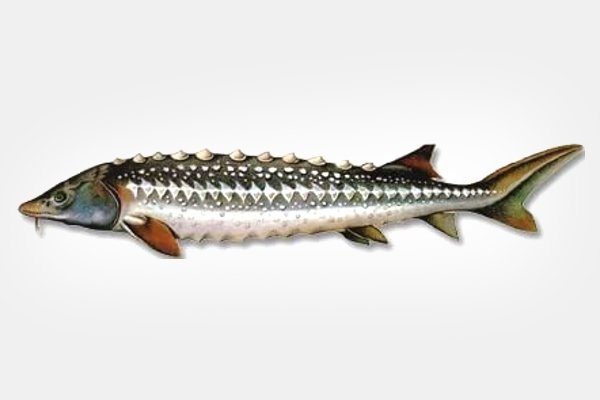
Beluga
A large fish, the weight of which can reach 1500 kilograms and a length of more than 4 meters. The fish's snout is similar in appearance to that of a pig. The mouth is large, sickle-shaped, the lips are thick. The eyes are small and blind. The body is covered with large scales. The back is grayish-brown in color, the belly is light, almost white.
Beluga lives in the Black, Azov and Caspian seas. Rarely found in the Adriatic Sea. It goes to spawning in the Dniester, Volga, Dnieper, Don, and Danube. Slightly less common in the Terek, Ural or Kura rivers.
Beluga fry feed on river plankton, caddis and mayfly larvae, eggs and fry of other fish. Having matured, the fish eat juvenile sturgeon and stellate sturgeon, crustaceans, mollusks, gobies or sprat, carp and herring.
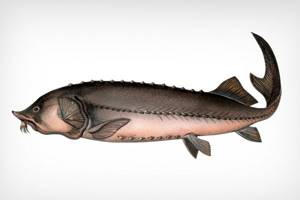
Sakhalin
A rare species of sturgeon. The average length of adult individuals reaches 1.5-1.7 meters and weighs 35-45 kilograms. The largest individuals can reach up to 2 meters and weigh about 60 kilograms. Adult Sakhalin sturgeons have a large, blunt snout and a greenish-olive color.
Sturgeons feed on various bottom inhabitants: snails, insect larvae, small shrimp, mollusks, crustaceans, and small fish.
The habitat covers the cold waters of the Seas of Japan and Okhotsk, the Tatar Strait. The sturgeon goes to spawn in the Tumnin River, located in the Khabarovsk Territory.
